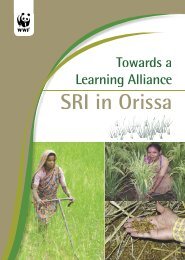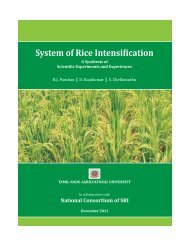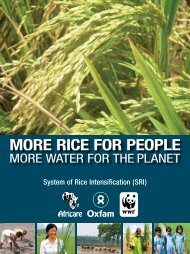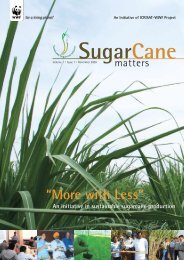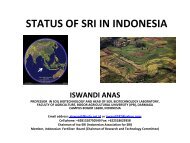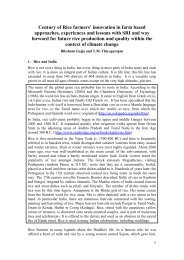Sustainable Sugarcane Initiative (SSI) manual - SRI - India
Sustainable Sugarcane Initiative (SSI) manual - SRI - India
Sustainable Sugarcane Initiative (SSI) manual - SRI - India
Create successful ePaper yourself
Turn your PDF publications into a flip-book with our unique Google optimized e-Paper software.
Background<br />
given that yields of 14% of cane weight at the time of cutting (and<br />
sometimes much higher) are possible. The Australian sugar industry<br />
for instance is regularly typified by sugar yields of around 14%,<br />
while yields of up to 25 tonnes of sugar per hectare have been<br />
reported in Hawaii!<br />
<strong>Sugarcane</strong> cultivation and the sugar industry in <strong>India</strong> are facing<br />
serious challenges due to various internal and external factors.<br />
The reasons for such low productivity are:<br />
• The improved varieties released by research organizations<br />
perform well in the initial years but lose their vigour and decline<br />
in yield in due course.<br />
World Sugar Production Forecast (2008-09)<br />
Million tonnes<br />
40<br />
30<br />
20<br />
10<br />
• Water availability is unpredictable. The concern is not only the<br />
quantity of water required, but also the lack of proper water<br />
management practices. Due to this, water is either wasted or<br />
sometimes not available at the right time.<br />
0<br />
China<br />
<strong>India</strong><br />
Thailand<br />
USA<br />
Brazil<br />
EU<br />
Australia<br />
2008 estimate 2009 forecast<br />
Source: Food Outlook, Global Market Analysis, Nov. 2008<br />
• Unpredictable climatic aberrations, improper cultivation practices, negligence in plant<br />
protection measures, imbalanced nutrient management and other practices like mono<br />
cropping often result in low productivity, fetching low price in the market.<br />
In addition, it is also very important to consider the enormous amount of water that goes<br />
into the sugarcane production. Approximately 25,000 kg of water is needed to produce 10 kg<br />
of sugarcane. But, the water table is depleting every year. Costs of production, moreover, are<br />
increasing not just for the small farmers but for the large industrial players as well. In future,<br />
these challenges will become even more complex with climate change inducing direct and<br />
indirect effects on crops, water, pests and diseases, and volatility in the international market.<br />
A recent FAO<br />
report predicts<br />
sharp shortfall of<br />
sugar production in<br />
<strong>India</strong> in the<br />
year 2009.<br />
<strong>Sugarcane</strong> research field<br />
Improving <strong>Sugarcane</strong> Cultivation in <strong>India</strong> 9





